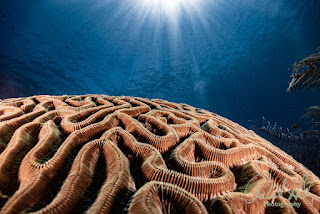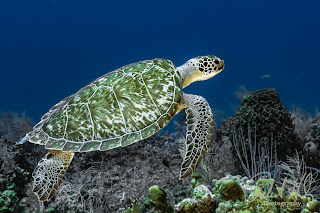AI-Powered Noise Reduction in Lightroom: A Game Changer for Underwater Photography
Copywrite - Robert Herb Photography
You're not alone if you’ve ever captured an incredible underwater moment only to find it riddled with unsightly digital noise obscuring your shot's beauty. As underwater photographers, we often navigate complex conditions such as low light, high ISOs, and the persistent challenge of backscatter, all of which contribute to grainy, noisy images that do not do justice to the stunning marine life we seek to document.
For years, we’ve relied on manual noise reduction techniques in Lightroom, delicately balancing the fine line between reducing noise and preserving the minute details that make underwater photography so captivating. Manual adjustments often require a keen eye and endless tweaking to achieve that perfect balance; it’s a meticulous process that can test the patience of any photographer.
However, Adobe’s introduction of the latest AI-powered Denoise tool revolutionizes noise reduction. Unlike traditional noise reduction methods, which can sometimes blur details or create unnatural image artifacts, the Denoise AI leverages advanced algorithms to intelligently eliminate noise while maintaining sharp details and vibrant colors. This represents a significant breakthrough for underwater shooters, who understand how crucial it is to retain the essence of their subjects in challenging photographic environments.
In this article, I’ll guide you through five effective noise-reduction techniques tailored for Lightroom. Each method is accompanied by precise steps, handy keyboard shortcuts, and expert tips designed to elevate your underwater photography. Whether you’re a seasoned pro or just starting out, these techniques will empower you to enhance the quality of your images and make the most of every underwater adventure.
Why AI-Powered Noise Reduction Is a Must for Underwater
Photography
In earlier versions of Lightroom, noise reduction tools were relatively basic, utilizing straightforward sliders for adjusting luminance and color noise. These controls allowed photographers to minimize grain appearance in their images, which was particularly beneficial in low-light scenarios. However, while these tools achieved some smoothing, they had significant drawbacks. One of the most notable issues was the tendency to blur fine textures. This blurring effect was especially problematic for marine life images, as it could render natural details, such as the intricate patterns of fish scales or the delicate features of corals, to look overly smooth and artificial. As a result, the realism and vibrancy of underwater photography were often compromised, prompting a demand for more advanced noise reduction methods that could preserve the integrity of fine textures while effectively reducing noise.
How AI-Powered Denoise Stands Out:
✅ Removes noise while
preserving fine details (scales, coral textures, fish eyes)
✅
Works best on high-ISO RAW files (ISO 1600+)
✅
No third-party plugins needed; now seamlessly integrated into Lightroom
✅
Generates a new DNG file with improved clarity
If you’ve been struggling with noisy underwater shots, AI-powered
Denoise in Lightroom Classic is the solution you’ve been waiting for.
1. Using AI Denoise for High-ISO RAW Images (Best for
Deep Water & Low Light Shots)
Adobe’s Denoise AI is perfect for high-ISO images
shot in dark or murky water. Unlike older noise reduction methods, AI
Denoise keeps fine details intact, making it a must-use tool for deep
wrecks, caves, or night dives.
How to Use AI Denoise in Lightroom:
- Open
your image in the Develop Module (D)
- Scroll
to the Detail Panel
- Click Denoise
- Adjust
the Denoise Amount Slider
- 🏊
50-70% for deep water shots with heavy noise
- 🌊
30-50% for mild noise reduction
- Click Enhance—Lightroom
will process the image and create a new DNG file
- Compare
the before/after result
📌 Shortcut Tip:
Press Z to zoom in and inspect details before applying Denoise AI.
2. Classic Noise Reduction (For Moderate Noise Without AI
Processing)
If your image doesn’t require complete AI-powered processing,
you can still reduce noise using Lightroom’s traditional noise reduction
sliders. This method is excellent for images with mild noise where AI
denoising might be overkill.
Steps to Apply Classic Noise Reduction:
- Enter
the Develop Module (D)
- Open
the Detail Panel
- Under Noise
Reduction, adjust:
- Luminance
Slider (Start with 25-40 for light noise)
- Detail
Slider (Increase to recover texture)
- Contrast
Slider (Fine-tunes results)
- Adjust
Color Noise Reduction if needed
- Compare
before/after
📌 Shortcut Tip:
Hold Alt (Option on Mac) while moving the Luminance Slider to see how it
affects the image in real time.
3. AI Super Resolution + Noise Reduction (For Extreme
Crops & Large Prints)
Ever taken a shot that was slightly too far away?
Maybe a shark in the distance or a shy octopus? Super Resolution AI,
combined with Denoise, can help.
How to Use AI Super Resolution + Denoise:
- Right-click
your image in the Library Module
- Select
Enhance (Ctrl + Alt + I / Cmd + Option + I on Mac)
- Check Super
Resolution
- Apply AI
Denoise
- Click Enhance. Lightroom
will create a high-resolution DNG file
📌 Shortcut Tip:
Use F for full-screen mode to inspect details before and after processing.
4. Mask-Based Noise Reduction (Targeted Adjustments for
Backgrounds or Selective Areas)
Not all parts of your image need the same level of noise
reduction. Masking in Lightroom lets you apply noise reduction selectively,
perfect for reducing noise in darker backgrounds while keeping your subject
crisp.
How to Apply Selective Noise Reduction:
- Open
the Develop Module (D)
- Click
the Masking Tool (Shift + W)
- Select
Select Subject or Select Background
- In the
Noise Reduction Panel, increase the Luminance Slider
- Adjust
the Detail & Contrast sliders to fine-tune the effect
- Click Done
📌 Shortcut Tip:
Press O to toggle the mask overlay to see which areas are
affected.
5. AI Noise Reduction in Lightroom Mobile (For Editing
On-the-Go)
Editing your underwater shots on your phone or tablet?
Lightroom Mobile now includes AI-powered noise reduction, making it easy
to clean up images before sharing them on social media.
Steps for AI Noise Reduction in Lightroom Mobile:
- Open
your image in Lightroom Mobile
- Tap
the Detail Panel
- Use Noise
Reduction AI or manually adjust Luminance & Detail
- Fine-tune
with Texture & Clarity
- Export
your final image
📌 Shortcut Tip: Press the Before/After icon to see how noise reduction affects the image
in real time.
AI-Powered Noise Reduction: A Must-Have for Underwater
Photographers
Adobe Lightroom’s AI-driven noise reduction is a game
changer, especially for underwater photographers with high-ISO
images. Whether you’re shooting in deep wrecks, night dives, or murky
conditions, AI-powered tools ensure your photos stay crisp, clear, and
detailed.
Key Takeaways:
✅ Use AI Denoise for heavy
noise in deep water shots
✅
Manually adjust noise sliders for mild noise reduction
✅
Combine Super Resolution & AI Denoise for extreme crops
✅
Apply selective noise reduction with masks for clean backgrounds
✅
Use Lightroom Mobile AI Noise Reduction for quick edits
Have you tried Lightroom’s AI-powered noise reduction
yet? Drop a comment below about your experience. I’d love to hear how it’s
improving your underwater shots!
Want to Take Your Underwater Photography Further?
- 💡 Read more Lightroom tips at RobertHerb.blogspot.com.
- 💡 Join my upcoming online training program – Learn to enhance your underwater shots with Adobe Lightroom! Send me an email so I can add you to my list.
- 💡 Share your processed photos on social media using #RobertHerbPhotography.
- 💡 Have questions? Email me at bob@robertherb.com.
Written by Robert Herb – Empowering underwater photographers to capture and enhance the beauty of our oceans.
Stay tuned for more in-depth insights into underwater photography. Let’s dive deeper into the art and craft of capturing the marine world! If you have any comments or suggestions, I’d love to hear them.
Get ready for an exciting underwater photography adventure! For more details on my upcoming online training course, check out my "Training" page at RobertHerb.com or email me at bob@robertherb.com.
Sincerely,
Bob Herb
|
|





Comments
Post a Comment
Please let me know your comments.